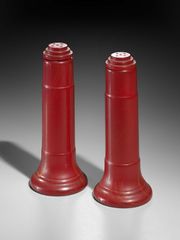Difference between revisions of "Phenolic resin"
| Line 1: | Line 1: | ||
| + | [[File:Bakelite2010488.1-2.jpg|thumb|Bakelite shakers<br>MFA# 2010.488.1-2]] | ||
== Description == | == Description == | ||
Revision as of 13:55, 6 December 2020
Description
Any of several thermosetting resins prepared by the condensation of Phenol with aldehydes (Formaldehyde, Acetaldehyde, furfural, etc.). Phenolic resins were first made in 1872 when Adolph Baeyer reacted phenol with acetaldehyde. Bakelite phenolic resins were developed by Leo Baekeland beginning in 1907. Examples of phenolic resins are Bakelite, Novolac and Catalin. Phenolic resins are used for molded parts, as adhesives and as varnishes.
See also phenol formaldehyde.
Synonyms and Related Terms
phenol resin; phenoplast; cast phenolic; resina fenólica (Esp.); résine phénolique (Fr.); resina fenolica (It.); resina fenólica (Port.)
Examples: Bakelite [Union Carbide]; Fiberloid [Monsanto]; novolac; Catalin; Marblette; Agatine; Durite; Durez; Prystal; Fiberlon; Opalon; Carvacraft
Comparisons
Physical Properties for Selected Thermoset Resins
General Characteristics of Polymers
Resources and Citations
- B.Barth, "Phenolic Resin Adhesives" in Handbook of Adhesives, I.Skeist (ed.), Van Nostrand Reinhold, New York, 1977, p.382-416.
- G.S.Brady, Materials Handbook, McGraw-Hill Book Co., New York, 1971 Comment: p. 599
- Ralph Mayer, A Dictionary of Art Terms and Techniques, Harper and Row Publishers, New York, 1969 (also 1945 printing)
- Theodore J. Reinhart, 'Glossary of Terms', Engineered Plastics, ASM International, 1988
- ASTM, "Standard Terminology Relating to Paint, Varnish, Lacquer and Related Products", Annual Book of ASTM Standards, Section 6, Paints, Related Coatings and Aromatics, ASTM, D16, 7-Jan, Jul-96
- Pam Hatchfield, Pollutants in the Museum Environment, Archetype Press, London, 2002
- Art and Architecture Thesaurus Online, http://www.getty.edu/research/tools/vocabulary/aat/, J. Paul Getty Trust, Los Angeles, 2000
